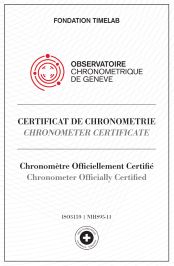Officially Certified: The Science of Chronometer Accuracy
Introduction
In the world of fine watchmaking, precision is paramount. The term “officially certified chronometer” is often associated with high-quality Swiss timepieces, but what does it actually mean? This designation signifies more than just superior accuracy—it is an assurance that a watch has met rigorous standards established by independent testing institutions. In this article, we will explore what an officially certified chronometer is, the standards it must meet, and why this certification is a mark of excellence in horology.
The History of Chronometer Certification
The pursuit of precise timekeeping dates back centuries. The need for accuracy was first driven by maritime navigation, where precise time measurement was essential for determining longitude at sea. Over time, scientific observatories began conducting chronometric tests, paving the way for modern chronometer certifications.
Switzerland, as a leader in watchmaking, has played a key role in establishing chronometer testing standards. The Geneva Observatory was one of the earliest institutions to evaluate and certify timepieces for their accuracy. Today, TIMELAB – Observatoire Chronométrique de Genève carries on this tradition, ensuring that watches meet strict chronometric standards.

What Defines an Officially Certified Chronometer?
For a watch to be designated as an officially certified chronometer, it must undergo stringent testing under controlled conditions. The most recognized standard for chronometer certification is ISO 3159, which defines the performance criteria a mechanical watch must meet to receive the title.
The certification process involves testing the watch movement over in different positions and temperatures. The key criteria assessed include:
-
Mean daily rate: The watch’s accuracy must remain within -4/+6 seconds per day.
-
Rate variation: The consistency of timekeeping across different positions.
-
Thermal influence: Performance stability when subjected to different temperatures.
-
Positional differences: Accuracy when the watch is placed in various orientations.
-
Rate recovery: How well the watch maintains its accuracy after temperature shifts.
Only movements that pass these tests receive the official chronometer certification, confirming their reliability and precision.

TIMELAB and the Observatoire Chronométrique de Genève
While COSC (Contrôle Officiel Suisse des Chronomètres) is the most well-known chronometer certification body, TIMELAB’s Observatoire Chronométrique de Genève provides an alternative, equally stringent certification. TIMELAB’s certification stands out because it ensures compliance with ISO 3159 standards while emphasizing transparency and traceability. Each certified movement receives a unique serial number and QR code, allowing owners to verify its authenticity online.

Why Chronometer Certification Matters
For collectors and watch enthusiasts, owning a chronometer-certified watch means more than just having a luxury timepiece. It offers:
-
Proven Precision: A certified chronometer guarantees a higher level of accuracy compared to standard mechanical watches.
-
Reliability: The rigorous testing process ensures the movement remains stable under various conditions.
-
Heritage and Craftsmanship: Chronometer certification is a testament to a brand’s dedication to quality and horological excellence.
-
Increased Value: Watches with official certification often hold or even appreciate in value over time.
This certification is not just about meeting a benchmark—it is a symbol of excellence in Swiss watchmaking.
 At BA111OD, our commitment to precision and authenticity aligns perfectly with the principles of Swiss chronometry. The Soprod P024 movements in our latest Chapter 7 timepieces undergo rigorous certification to ensure they meet the highest standards, offering collectors the assurance of true Swiss excellence.
At BA111OD, our commitment to precision and authenticity aligns perfectly with the principles of Swiss chronometry. The Soprod P024 movements in our latest Chapter 7 timepieces undergo rigorous certification to ensure they meet the highest standards, offering collectors the assurance of true Swiss excellence.

How to Identify a Certified Chronometer Watch
When purchasing a watch, look for the following indicators to confirm that it is an officially certified chronometer:
-
Engraved Designation: Some brands engrave “Chronometer” on the dial or case back.
-
Official Certification Document: The watch should come with an official chronometer certificate.
-
Serial Number Verification: With TIMELAB-certified watches, you can verify authenticity online using a QR code.
FAQs
1. What does it mean when a watch is a certified chronometer?
A certified chronometer is a watch that has passed rigorous testing for accuracy and reliability under the ISO 3159 standard. It is independently tested by institutions like TIMELAB or COSC.
2. Is a chronometer watch better than a regular mechanical watch?
Yes. Chronometer-certified watches are held to higher accuracy standards, making them more precise and reliable than standard mechanical watches.
3. Who certifies chronometer watches in Switzerland?
The two most recognized certification bodies are COSC (Contrôle Officiel Suisse des Chronomètres) and TIMELAB – Observatoire Chronométrique de Genève.
4. How do I verify if my watch is a certified chronometer?
Check for an official certificate, an engraved “Chronometer” marking, or use a QR code (if provided by TIMELAB) to verify authenticity.
Conclusion
An officially certified chronometer is more than just a watch—it is a mark of precision, reliability, and Swiss craftsmanship. Whether tested by COSC or TIMELAB, these watches undergo rigorous testing to ensure exceptional performance. For collectors, a certified chronometer represents an investment in timekeeping excellence.
As Swiss watchmaking continues to push boundaries, chronometer certification remains a gold standard, ensuring that fine mechanical timepieces uphold the highest precision standards. If you value accuracy and heritage, a certified chronometer watch is a worthy addition to your collection.






Leave a comment